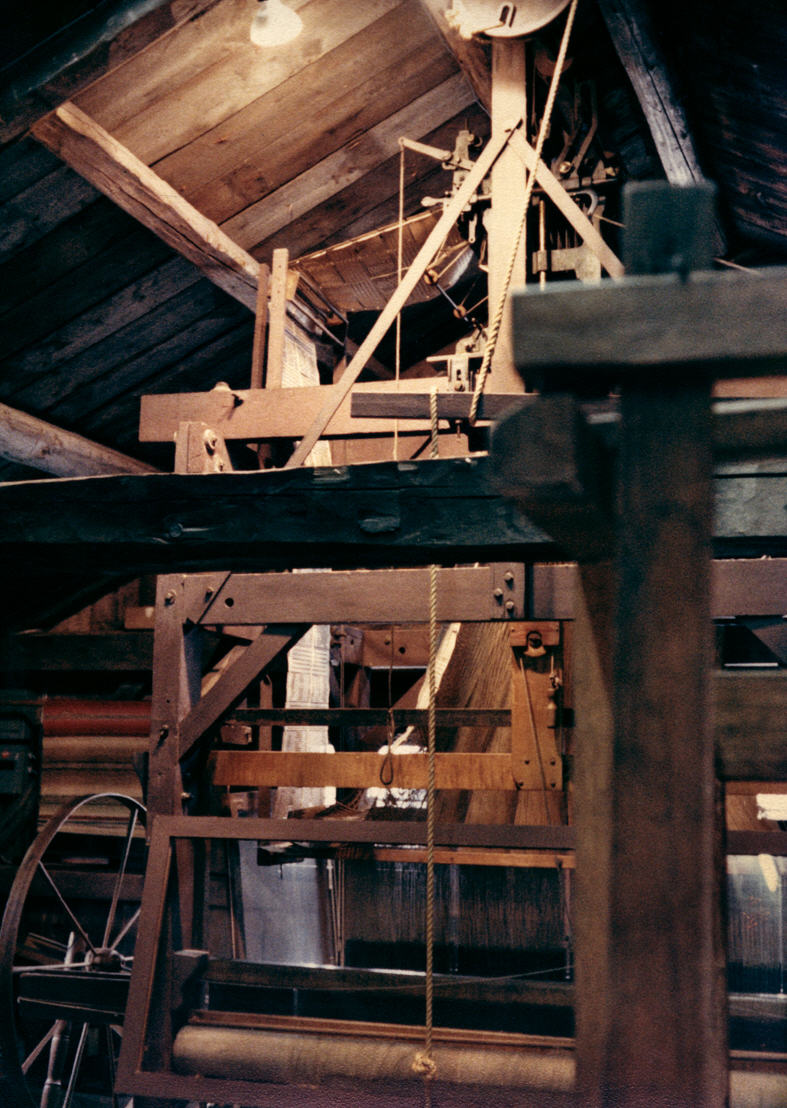The Jacquard Loom

This working Jacquard loom is at the Shelburn Museum near Burlington, Vermont (USA). To the left center on the far side of the loom you can see the light-colored "deck" of punched cards that control the loom. On top is the "card reader". In fact, the deck is a loop; the cards are attached edge to edge and go round and round through the reader, producing a repeating pattern. The intricate fabric designs of the 1800s were highly prized and sometimes -- in an early instance of software piracy -- card decks would be stolen by competing textile mills.

The punched-card idea was adopted later by Charles Babbage about 1830 to control his Analytical Engine, and later still by Herman Hollerith for tabulating the 1890 USA census. The image above (of a different loom) is from [69] and shows the punched cards a bit more clearly.
As Lady Ada Lovelace (the world's first programmer) said, regarding the use of punched cards as the control medium for the Babbage Analytical Engine, "the Analytical Engine weaves algebraical patterns just as the Jacquard-loom weaves flowers and leaves."[1]
The importance of punched cards in weaving can hardly be oversated. Prior to their introduction, a loom would have to be built (or configured or modifed) for each specific textile pattern, whereas with punched-card control, the same loom could produce an unlimited number of patterns simply feeding it different cards. The same was true of early electronic computers; although the data for a task was typically read from punched cards, the steps of the task — the program — was either hardwired into the computer (as in Hollerith's 1890 census tabulator) or controlled by a plugboard (Hollerith's 1906 tabulator and most subsequent computing equipment through the late 1940s, when Babbage and Lovelace's idea of reading the operating instruction (the program itself) from cards was revived, for example in IBM's Card-Operated Table Printer in 1945 (to some extent), or in its Card Programmed Calculator in 1946-47.
References
- Stephen Wolfram, Untangling the Tale of Ada Lovelace, writings.stephenwolfram.com, 10 December 2015 (accessed 30 December 2020). Thanks to David Marans for this reference.
Offsite Links
- Punched card, Wikipedia, accessed 29 May 2019.
- The IBM Punched Card, IBM100 anniversary pages.
- Punch Card Loom (Victorian Web).
- Hollerith reikäkorttikoneet, Ilkka Kekkonen (in Finnish).
- Punched Cards - A brief illustrated technical history, Douglas W. Jones, University of Iowa.
Translations of this page courtesy of...
| Language | Link | Date | Translator | Organization |
|---|---|---|---|---|
| Belarusian | Беларуская | 2023/08/22 | Vladyslav Byshuk | Владислав Бишук | studycrumb.com |
| Czech | Čeština | 2023/08/22 | Vladyslav Byshuk | Владислав Бишук | skyclinic.ua |
| Finnish | Suomi | 2023/08/31 | Kerstin Schmidt | https://writemyessay4me.org/ |
| French | Français | 2023/08/25 | Kerstin Schmidt | prothesiswriter.com |
| German | Deutsch | 2023/08/25 | Kerstin Schmidt | writemypaper4me.org |
| Italian | Italiano | 2023/08/31 | Kerstin Schmidt | https://admission-writer.com/ |
| Polish | Polski | 2023/08/25 | Kerstin Schmidt | justdomyhomework.com |
| Russian | Русский | 2023-07-16 | Alexey | Plastic Recycling Company |
| Spanish | Español | 2023/08/31 | Kerstin Schmidt | https://pro-academic-writers.com/ |
| Ukrainian | Українська | 2023/08/22 | Vladyslav Byshuk | Владислав Бишук | studybounty.com |